Huawei
FCC Will No Longer Authorize Communications Equipment from Huawei, ZTE
The FCC has just adopted an even stricter stance against communications equipment from Chinese companies such as Huawei and ZTE, implementing a more complete ban. The US government has already taken a number of steps to constrain Chinese telecom equipment companies in recent years, effectively shutting them out of the US market, as well as many western markets. But the FCC has still accepted applications from the companies for "equipment authorization", which involves testing radios to ensure compliance with FCC rules that prevent radio interference, etc. This is a requirement for the importation and sale of any radio equipment (or equipment that could interfere with radios) in the US. Now the FCC will no longer issue authorizations for "communications equipment deemed to pose an unacceptable risk to national security". "The new rules implement the directive in the Secure Equipment Act of 2021, signed into law by President Biden last November, that requires the Commission to adopt such rules." While the new rules apply only to new equipment going forward, "The Commission is also seeking comment on future action related to existing authorizations."
Huawei Exploring New Business Model to Stay in Phone Business
Bloomberg reports that Huawei is in talks to license its smartphone designs to other companies. US sanctions have cut Huawei off from critical hardware and software needed to make smartphones, restrictions that might not apply to potential licensees.
Huawei to Charge Phone Makers for 5G Patents
Chinese telecom giant Huawei announced plans to be more aggressive about collecting royalties for its patents related to 5G technology, including collecting up to $2.50 per 5G smartphone sold. Huawei has over 3,000 patents related to 5G, about 18% of which are essential to the 5G standard, according to intellectual property research organization GreyB. Huawei is not alone in charging royalties for patents on 5G technology. Nokia and Ericsson each already charge more than $2.50 per smartphone sold. Huawei was previously more restrained about collecting on its 5G patents while it focused on selling its own 5G equipment and devices around the world. But since the actions of the US government have crippled Huawei's smartphone business worldwide, the company seems to be focusing on new revenue streams.
ARM Halts Business With Huawei
ARM has stopped doing business with Huawei, potentially ending Huawei's mobile chip business. Essentially all current processors for mobile phones are based on ARM technology and intellectual property. Crucial processor and SoC chips from Qualcomm and Apple are based on ARM designs. Similarly, Huawei's own Kirin chips rely on ARM intellectual property (IP). All major mobile OSes, such as Android, are designed to work on ARM's architecture. The US government recently barred US companies from doing business with Huawei, cutting off Huawei's access to hardware from Qualcomm and software from Google. Huawei was relying on its own Kirin chips to continue making phones independently of Qualcomm, but Kirin chips face an uncertain future without access to ARM IP. This challenges Huawei's future ability to make phones and sell them outside of China. ARM is headquartered in Cambridge, UK and it owned by Japanese conglomerate SoftBank, but ARM has significant offices in the US and its designs contain "US origin technology".
Trump Ban Cuts Huawei Off From Google's Android
The Trump administration issued an executive order last week preventing "foreign adversaries" from doing telecommunication business in the US. Although the order's wording was vague, the implementation includes preventing Huawei from doing business with any US software or hardware supplier, including Google, Intel, Qualcomm, and Broadcom. This means Huawei will no longer be able to ship new phones to western markets with Google's version of Android that includes the Play Store, Google Maps, Google Assistant, and Gmail. Huawei can still use the open-source version of Android, but Android phones without Google services are a tough sell in western markets. Although Huawei can use its own SoC chips instead of Qualcomm's, being cut off from US hardware suppliers is likely to affect its smartphone business worldwide. The company has reportedly been stockpiling chips and parts from US companies for months to prepare for this possibility.
Huawei Sues US Government, Appealing Ban on Buying Huawei Gear
Huawei is appealing a recent law restricting the purchase of Huawei and ZTE products at the federal level. Huawei is suing the US government in a Texas court, where its US headquarters is located. The law in question is the most recent National Defense Authorization Act. It bars the federal government from buying Huawei gear directly, and from doing business with companies that use a substantial amount of Huawei hear. It also prevents private companies from using federal grants or loans to purchase Huawei gear. Huawei claims these provisions are unconstitutional because they violate its right to due process, and are a violation of the separation of powers.
US Gov't Indicts Huawei for Stealing Trade Secrets from T-Mobile
The US government is pursuing a criminal case against Huawei for stealing the design for — as well as actual parts and software from — a unique phone-testing robot developed by T-Mobile USA. The gov't alleges that Huawei offered bonuses for employees to steal such trade secrets, and obstructed justice in a related civil case. A Seattle grand jury returned a 10-count indictment for theft of trade secrets conspiracy, attempted theft of trade secrets, seven counts of wire fraud, and one count of obstruction of justice. The robot in question is called "Tappy" and simulates human fingers activating a set of actions on a phone being tested. The theft occurred in 2012 and 2013. T-Mobile pursued a civil case against Huawei in 2014, and in 2017 a jury awarded T-Mobile $4.8 for Huawei's breach of contract. In the civil case, T-Mobile alleged that Huawei employees authorized to use Tappy snuck another, unauthorized Huawei employee into T-Mobile's labs to photograph Tappy. A Huawei employee also stole one of Tappy's "fingers" and copied some of its software. T-Mobile provided surveillance photos to back its claims, and Huawei admitted to several of the allegations. Under the maximum sentencing provisions applicable to corporate entities, Conspiracy and Attempt to Commit Trade Secret Theft are punishable by a fine of up to $5,000,000 or three times the value of the stolen trade secret, whichever is greater. Wire Fraud and Obstruction of Justice are punishable by a fine of up to $500,000.

Hands On with the Honor View20
The good news is that the eye-catching Honor View20 seems like a great phone. The bad news is that it's not clear it will come in a version that will work remotely well on US networks. The back has an eye-catching design. The front has a huge 6.4-inch edge-to-edge screen with a "pin-hole punch" instead of a notch. Inside is a top-end Kirin 980 processor and super hi-res cameras front and back. It has zillions of other features, including a laser 3D scanner. We checked it out.
Trump May Declare a 'National Emergency' to Block Huawei, ZTE
President Donald Trump is weighing new action against Chinese telecommunications equipment makers Huawei and ZTE, says Reuters. The President might issue an executive order that would bar U.S. companies from buying telecom gear from either. Some in the U.S. government insist Huawei and ZTE have deep ties to the Chinese government. That relationship could give China the power to spy on the U.S., a claim Huawei has denied many times. Trump has been considering the executive order for more than eight months. The order would rely on the Department of Commerce to block equipment purchases from "foreign telecommunications makers that pose significant national security risks," say Reuters' sources. Huawei and ZTE themselves may not actually be named in the order. Such an order would hinge on the International Emergency Economic Powers Act, which gives the President power to govern commerce directly when a national emergency threatens the U.S. Trump has already barred the U.S. government itself from purchasing equipment from Huawei and ZTE. The four largest carriers mostly rely on equipment from Ericsson, Nokia, and Samsung, but smaller, rural operators do use gear from Huawei and ZTE. They are worried the Trump administration will force them to rip out existing Chinese-made gear at their own expense. Reuters says Trump may issue the order as soon as January.
T-Mobile, Sprint Parents May Drop Huawei Gear to Facilitate Merger
T-Mobile and Sprint expect their proposed merger will be given the green light by government security officials as soon as next week, according to a report from Reuters. The Committee on Foreign Investment in the United States (CFIUS) has been reviewing the merger for potential security issues. At the same time, government officials have been pressuring Deutsche Telekom, T-Mobile's parent organization, and SoftBank, Sprint's parent organization, to cease use of Huawei networking gear. The U.S. insists that Huawei gear may include a back door that could be accessible to the Chinese government for spying purposes. Deutsche Telekom agreed to review its use of Huawei gear in its home country of Germany and other European markets. SoftBank says it will replace 4G Huawei equipment with new gear from Nokia and Ericsson. These concessions appear to be enough for CFIUS, say Reuters' sources, and the security committee may grant T-Mobile and Sprint the permission they need to move forward with the merger. The deal still needs to be approved by the FCC and Department of Justice. The companies expect the deal to be finalized in early 2019. None of the firms mentioned by Reuters offered comment on the report.
Huawei CFO Freed On $10M Bail, Must Remain in Canada
Canada has released Meng Wanzhou, Huawei's CFO, after her lawyers convinced a judge to grant bail. Meng was arrested in Vancouver on December 1 at the behest of the U.S. Department of Justice. The U.S. alleges Meng has defrauded multinational banks concerning equipment sales to Iran, in violation of U.S. sanctions. Meng had to pay $10 million, turn in her passport, and agree to wear an ankle monitor in order to secure bail. She is also confined to her home during the overnight hours. While on bail, a Canadian judge will review the U.S. case against Meng to determine if it is strong enough to warrant extradition. If the case passes this examination, Canada's minister of justice would then have to agree with the extradition request before she could be handed to U.S. authorities. Meng is facing penalties of up to 30 years per charge. The arrest has further strained the tenuous relationship between China and the U.S. Later, President Trump said he might intervene in the case in order to ensure national security interests are upheld or to facilitate a trade agreement with China.
Huawei's Meng Facilitated Deals with Iran, Says U.S.
Huawei CFO Meng Wanzhou is facing extradition to the U.S. so she can face accusations that she hid connections with a company in order to sell sanctioned equipment to Iran. The U.S. first issued a warrant for Meng's arrest in August; she was arrested on Dec. 1 in Vancouver and has been held there since. The government alleges that Meng relied on Skycom Tech Co, based in Hong Kong, to sell HP computers to Iran in violation of U.S. and EU law. Skycom had an office in Tehran and was effective run by Huawei. She faces charges of conspiracy to defraud multiple financial institutions, which could carry a prison sentence of 30 years. Meng sought bail in a hearing held today in Vancouver. The U.S. now has 60 days to formally request Meng's extradition. A Canadian judge will ascertain whether or not the case against Meng is strong enough. If deemed solid, Canada's justice minister will be responsible for making the decision to turn her over. The U.S. has long held that Huawei's ties to the Chinese government are too close, and that Huawei represents a security risk to the country. The government has already banned employees from using Huawei phones. Early this year, AT&T, Verizon Wireless, and others shelved plans to sell Huawei phones. Carriers are prohibited from using Huawei's telecommunication equipment, and the U.S. has advised carriers in other countries to also ban Huawei gear.
Huawei Investigation Suggests Bank Fraud Involving HSBC
Reuters today reports that the U.S. investigation into Huawei's potential violation of sanctions involves "an alleged scheme to use the global banking system to evade U.S. sanctions against Iran." The U.S. has been looking into Huawei's behavior since 2016, and recently focused on the company's use of HSBC to hide transactions made with Iran. HSBC was itself investigated by the U.S. Attorney's office in Brooklyn for violating sanctions and money-laundering laws, and paid a fine of $1.92 billion in 2012. Reuters' source says HSBC is not under investigation at this time. The U.S. took dramatic action on its investigation when it had Huawei CFO Meng Wanzhou arrested in Canada. Meng is expected to be extradited to the U.S. The U.S. has maintained for some time that Huawei represents a security threat due to its ties with the Chinese government. Representatives from Huawei and HSBC declined to comment on Reuters' story. Earlier this year, China-based ZTE was penalized by the government for similar transgressions involving Iran.
U.S. Gov't Sets Sights on Huawei for Violating Iran Sanctions
The Wall Street Journal reports that Canadian authorities have arrested the CFO of Huawei — who is also the founder's daughter — at the request of U.S. authorities. The charge relates to alleged violations of U.S. sanctions on Iran. The U.S. government made a similar case against ZTE (Huawei and ZTE are both Chinese companies,) which at one point threatened ZTE's entire global business. The government has already pressured U.S. companies and allied governments to stop doing business with Huawei over spying concerns. This new action against Huawei will likely affect the current administration's on-again/off-again trade war with China. The executive, Meng Wanzhou, will be extradited to the U.S. and face a bail hearing on Friday.
US Warns Allies to Stay Away from Huawei Networking Gear
The U.S. government has contacted foreign allies and asked them to refrain from purchasing telecommunications gear from Huawei, according to the Wall Street Journal. The U.S. reached out to Germany, Italy, and Japan to warn them of what it perceives as security risks in equipment from the Chinese manufacturer. The countries contacted by the U.S. host military bases, which is one of the top concerns. While sensitive military information is transmitted via satellite, a lot of communication still travels over commercial networks. The U.S. government already prevents U.S. carriers from using gear from Huawei, and has also forbid government employees from buying Huawei phones. The U.S. waved a carrot stick at allies in the form of foreign aid, which government officials say will be increased for countries that shun equipment from Huawei. Though the government has cautioned against Huawei gear for years, the Trump administration has taken a more active approach in squashing Huawei's business prospects in the U.S. Huawei did not comment on the Journal's story.
Netflix HDR Support Reaches More High-End Phones
Netflix has added more smartphones to the list of those capable of supporting HDR10 playback. The newest phones include the LG G7, and the Sony Xperia XZ2 Premium and Xperia XZ3. These phones have the high-contrast displays needed to boost colors and improve the visible range between bright and dark regions of each frame. HDR10 playback is already available to a number of flagship-grade devices, including the LG G7 One, V30, and V35; the Samsung Galaxy Note9, Note8, and S9; the Sony Xperia XZ Premium, XZ1, and XZ2; and the Huawei Mate 10 Pro, P20, and Honor 10. In order to view HDR10 content on mobile devices, people need to subscribe to the premium Netflix plan.
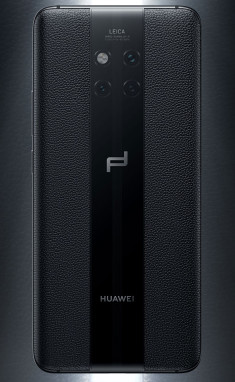
Huawei Mate 20 Series Gains an X and a Porsche Design
Huawei today unveiled two devices apart from the Mate 20 and Mate 20 Pro. First up, the Mate 20 X is a massive slab with a 7.2-inch screen and a 5,000mAh battery. Huawei is pitching the phone as a gaming device. It relies on a graphene film and vapor chamber to keep the Kirin 980 CPU/GPU cool, which translates to faster speeds for longer periods of time. The phone includes the same 40-megapixel ultra-wide-angle camera that's found on the Mate 20 Pro. It supports pen-based input and has an IP53 rating for protection against minor splashes. The Mate 20 X will retail for €899 and goes on sale October 26. The Mate 20 Porsche Design RS (pictured) features a custom-designed chassis that was inspired by Porsche's racing legacy. It has a glass racing stripe on the rear panel that's surrounded by leather. The phone has a more round shape than that of the other Mate 20 phones, but shares all the specs with the Mate 20 Pro. The Mate 20 Porsche Design RS will start at €1,649 and goes on sale in November.
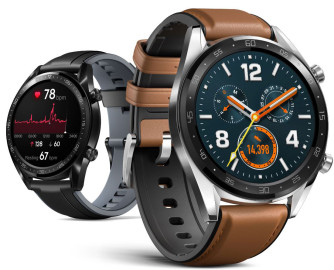
Huawei Watch GT Drops Wear OS for Huawei's Own Platform
Huawei today announced the Watch GT, a smartwatch that has a traditional appearance and focuses on fitness. Huawei says the Watch GT is designed for "urban explorers" and can track a wide range of activities. The device can automatically track running, swimming, cycling, cross fit, hiking, and walking. The device has a round, 1.39-inch AMOLED screen that's surrounded by a ceramic-coated bezel and stainless steel chassis. The wearable features excellent battery life. It relies on a dual-chip system so it can separate low- and high-power tasks. Huawei says it relies on AI to understand what the wearer is doing and it will automatically switch to power-saving mode when it can. As a result, the device supports up to two weeks of battery life with the heart rate monitor on and tracking 90 minutes of activity per week. With heart rate and GPS off, the wearable can offer the time, messages, and calls for up to 30 days. With continuous exercising, and the GPS/heart rate monitor active, the battery lasts about 22 hours. The device features a six-sensor heart rate monitor to record the most accurate measurements. The UI is not based on Google's Android Wear OS, as Huawei's older watches are. Instead, it favors a Wear OS-like UI that Huawei developed itself. The Classic version costs €249 and the Sport version costs €199. They will be available later this month.
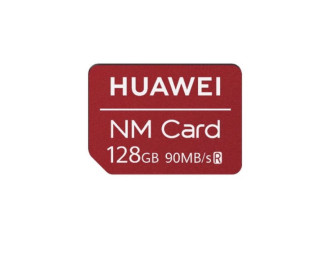
Huawei Created Its Own Memory Card Shaped Like a Nano SIM
Huawei today showed off a new memory card format to accompany its flagship Mate 20 Pro smartphone. The Mate 20 Pro supports two SIM cards, but not a traditional microSD memory card. In order to give people the option to add storage to the Mate 20 Pro, Huawei made a memory card that's shaped and sized like a nano SIM card. Huawei didn't say what storage allotments the card will come in, though it did show a 128 GB card on stage. There's no word on pricing or availability, and Huawei didn't say how the memory card interfaces with the SIM connector.
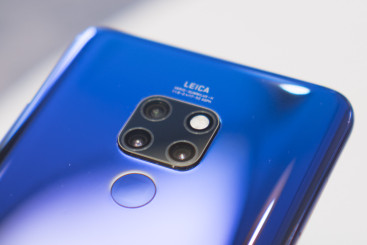
Hands On with the Huawei Mate 20 and Mate 20 Pro
Huawei’s latest phones, the Mate 20 and Mate 20 Pro, are impressive metal-and-glass slabs that go toe-to-toe with the best from Apple, Google, LG, and Samsung. Those seeking non-carrier fare will find plenty to like about this powerful pair of intelligent devices. Here are Phone Scoop’s initial impressions.
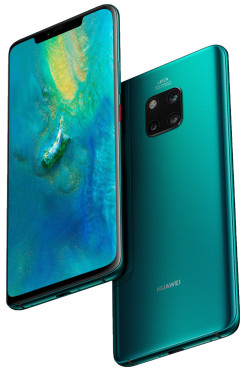
Huawei’s Mate 20 and Mate 20 Pro Take Aim at Galaxy Note9
Huawei today announced it flagship series for the year, the Mate 20 and Mate 20 Pro. The phones share a number of features, but have their own identity thanks to differences in the screen and chassis. The most distinctive feature is the camera module on the rear, which is square-shaped and contains three cameras and the LED flash. Both the Mate 20 and Mate 20 Pro are powered by Huawei’s Kirin 980 processor, which it says delivers even more AI-based smarts than its last-generation chip. The Kirin 980 features dual neural processing units to improve image recognition, Master AI for processing 1,500 different scenes, and predictive focus for tracking subjects in real time. Other shared features include Cat 21 LTE with dual SIM cards, Bluetooth 5.0, WiFi, GPS, and support for 256 GB memory cards. Both include a 24-megapixel selfie camera at f/2.4, and come in five colors, including green, blue, twilight, pink gold, and black. The devices run Android 9 Pie with Huawei's EMUI 9.0 skin on top. EMUI 9.0 is pared back a bit when compared to EMIO 8.0, and features business software as well as the ability to project a desktop mode to wireless displays.
- Mate 20 Pro: The Mate 20 Pro is the higher-end version of the two phones. It boasts a notched 6.39-inch curved OLED display with quad HD+ resolution and support for HDR. The Mate 20 Pro includes a fingerprint reader buried under the display, as well as 3D facial recognition for security. The phone features three rear cameras contained in a square module on the rear. The main camera has a 40-megapixel sensor at f/1.8, and it is joined by an ultra wide-angle 20-megapixel sensor at f/2.2, and an 8-megapixel 3x telephoto sensor at f/2.0. The phone supports wireless charging and can even act as a charger for other devices. The battery is rated at 4,200mAh. It comes with 6 GB of RAM and 128 GB of storage.
- Mate 20: This device has a "teardrop" notched screen that measures 6.53 inches across the diagonal with full HD+ resolution. The Mate 20 also features a three-camera array on the back with a main sensor of 12 megapixels at f/1.8, a wide-angle sensor of 16-megapixel at f/2.2, and an 8-megapixel 2x telephoto sensor at f/2.4. The phone supports wireless charging and the battery is rated at 4000mAh. It comes with either 4 or 6 GB of RAM and 128 GB of storage and a rear-mounted fingerprint reader for security.
Fortnite for Android No Longer Requires An Invitation
Epic Games today made its popular Fortnite game available without an invitation. The app has been available in beta since August, though an invite was required for access. Epic Games has dropped the need for an invitation and most anyone can download the game. Fortnite is not available in the Google Play Store. Instead, people interested in the game will need to go to Epic's web site to download an installer. The installer then puts the game on the phone. The game started as an exclusive to the Samsung Galaxy Note9 and was later discovered to have a major security flaw in the installer (since patched). Fortnite is best played on high-end devices that have Android 8 Oreo installed. Some compatible phones include the Samsung Galaxy S7, S8, and S9 series; all Google Pixel phones; the LG G5, G6, G7, V20, and V30; the Asus ROG Phone and 5Z; the Essential Phone; the Huawei Mate 10, Mate 10 Pro, Honor 10, and Honor Play; the OnePlus 5, 5T, and 6; the HTC 10, U Ultra, U11+, U12+; the Sony Xperia XZ1, XZ2, and XZ3 series; as well as a handful of others from Xiaomi, ZTE, Nokia, and Lenovo.
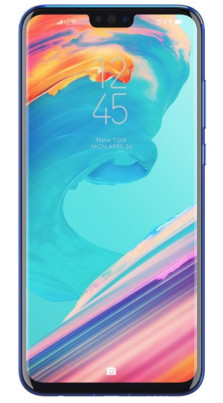
Huawei’s Honor Brand Fully Reveals the 8X
Honor today announced the 8X, a new mid-range phone that offers many of today’s most-wanted features in a more affordable package. The 8X has a metal frame and two 2.5D glass panels forming the front and back. The device boasts a 6.5-inch FullVision display with full HD+ resolution at a 19.5:9 aspect ratio. Honor says its chip-on-film technology and new antenna design allowed it to achieve a 4.25mm bezel along the bottom of the display, with a total screen-to-body ratio of 91%. The phone is powered by an octa-core Kirin 710 processor, based on the 12nm ARM Cortex A73, with a Mali G51 GPU. The 8X has a two-camera setup on the back, with a 22-megapixel full color main sensor at f/1.8 and a 2-megapixel depth-sensing secondary sensor for portrait/bokeh effects. The phone carries over some of the AI-based features of Huawei’s pricier flagships, such as automatic scene detection, blur reduction, and 3D portrait lighting. It can capture slow-motion video at up to 480fps. The front-facing camera has a 16-megapixel sensor at f/2.0. Other features of the 8X include a 3,750mAh battery, fingerprint reader, face unlock, 4/6 GB of RAM, 64/128 GB of storage, and support for two SIM cards. Based on the LTE bands included in the variants, it appears as though the phone may not be compatible with U.S. networks. Honor has not said exactly when the 8X will go on sale, nor what markets it will reach.
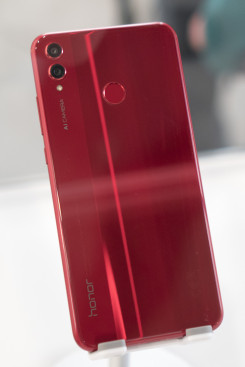
Preview: Honor 8X
Huawei's Honor brand is gearing up to announce the Honor 8X, a new mid-range Android phone with a large screen and a unique design. Huawei hasn't announced full details yet, but they did let us photograph it.
Huawei to Let Device Owners Access 'Performance Mode'
Huawei says customers will eventually be able to access and turn on their phone's Performance Mode. The action comes about after Huawei was caught by AnandTech cheating on certain benchmark tests, include 3DMark. Some Huawei and Honor phones could detect the test and boost performance to improve the result. In response, 3DMark delisted the Huawei P20, P20 Pro, Nova 3, and Honor Play from its rankings. Explaining the issue, Huawei said, "The latest Huawei handsets leverage innovative technologies such as artificial intelligence to optimize resource allocation in a way so that the hardware can demonstrate its capabilities to the fullest extent, while fulfilling user demands across all scenarios." 3DMark says it is opposed to this approach, as it believes benchmark apps should be run as if they were any other app. Moving forward, Huawei will provide users with open access to Performance Mode — which boosts speeds at the expense of battery life — in the forthcoming EMUI 9.0 platform. Huawei says EMUI 9.0 will reach select phones, including the Mate 10 Pro and P20 Pro, later this fall.
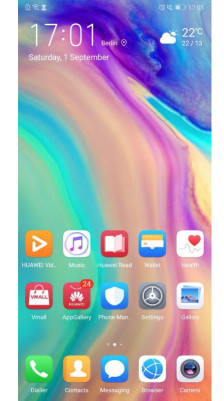
Huawei Intros Android 9 Pie-Based EMUI 9.0
Huawei today revealed its forthcoming user interface skin, EMUI 9.0. The new user experience is based on Android 9 Pie, which means it offers many of the new features included in Google’s code. Huawei said its goal in developing EMUI 9.0 was to simplify the experience and make it more consistent. For example, it has reduced the number of options in its settings menu from 940 in EMUI 8.0 to 843 in EMUI 9.0. The company’s designers have pared back the look of individual apps and given them a consistent look across the user interface. Huawei also sought to make the UI more natural. It features nature-based wallpapers, backgrounds, and even sounds for the alarms and alert tones. The clock app will tick with the sound of a real clock and the keyboard will clack with the sound of a mechanical typewriter. The UI looks to smooth over navigation. For example, Huawei will move app controls to the bottom of the screen, where they are easier to reach, whenever possible. A new swiping gesture on the home screen will call up a navigation panel for jumping to select apps and settings. EMUI 9.0 also introduces GPU Turbo 2.0 with a focus on mobile gaming. Huawei insists its new algorithms improve GPU efficiency and reduce power needs during gaming, all while delivering smoother performance. Huawei claims EMUI 9.0’s GPU as run on its new Kirin 980 SoC performs significantly faster than the Qualcomm Snapdragon 845. Last, a password vault is being added to the platform to help with app logins. People will be able to store usernames and passwords in the secure zone and then call them up using a fingerprint reader or facial recognition when signing into apps. Huawei is offering EMUI 9.0 in beta form to select devices. It will eventually be seeded to the Mate 10, Mate 10 Pro, P20, P20 Pro, Honor 10, 10 View, and Play.
ZTE Committed to US Market, Denies Security Risk
Now that ZTE has resumed full operations, the company is focused on rebuilding its U.S. business. While the new Axon 9 Pro flagship is not going to be sold in the U.S, ZTE does plan to bring at least one new phone to the U.S. market before the end of the year, said executive Jeff Yee. ZTE is working to repair its relationships with U.S. carriers, where it found success with affordable phones with large screens. Yee wouldn't say if it's next U.S.-bound device will be a low-cost phone or a premium phone. Initially, the company will likely sell new devices through the open market, rather than via carriers. ZTE also flatly denies that its phones pose any sort of security risk to Americans. The U.S. government has targeted ZTE and Huawei this year, claiming phones from the two companies could be used by the Chinese government for spying. The government has issued orders preventing government workers from using ZTE or Huawei phones for government work. Yee says the company doesn't send any data from its phones to China, and its phones are secure. ZTE believes it can recoup at least some of its lost business as it pushes forward.
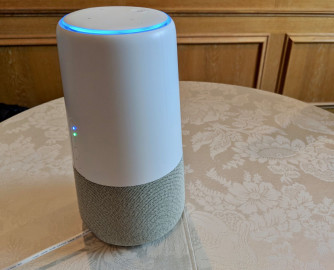
Huawei's AI Cube Speaker Looks to Challenge Google Home
Huawei today introduced the AI Cube, an in-home speaker that relies on Amazon Alexa for voice-based smarts. The AI Cube is unique in that it supports Cat 6 LTE and can serve as a mobile hotspot when needed. It includes dual-band WiFi for connecting phones, tablets, and other devices that rely on WiFi. The speaker has a 400ml sound cavity and aluminum diaphragm that are controlled by Huawei's Histen AI for dynamically adjusting bass response and gain to suit the surroundings. It has a 15W mono speaker and four microphones to support far-field voice recognition. The AI Cube has a white chassis and is available in three different mesh base colors. Huawei didn't announce pricing or availability of the AI Cube.
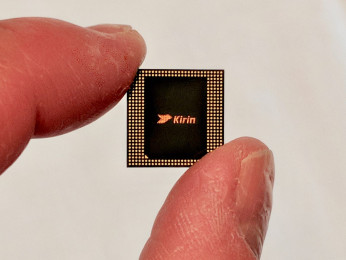
Huawei Intros Kirin 980, a 7nm SoC for Next-Gen Smartphones
Huawei today announced the Kirin 980, its premiere system-on-a-chip for mobile devices. The chip adopts a 7nm process, allowing for a 20% boost in power output and a 40% jump in efficiency when compared to Huawei's 10nm process. The chip employs eight cores in a unique configuration. It includes two high-performance ARM Cortex A76 cores, two high-efficiency A76 cores, and four extreme-efficiency Cortex A55 cores. Huawei says a flex-scheduling subsystem assigns tasks to the appropriate cores as needed. The 980 adopts the Mail G76 GPU, which offers 46% greater graphics processing power and 178% improved efficiency. Clock boosting technology allows the G76 identify games and adjust accordingly. Huawei has given the Kirin 980 two NPUs (neural processing units) to improve on-device AI. The chip can identify 4,500 images per minute. The new image signal processor improves data throughput by 46% and better supports multi-camera configurations. It handles multi-pass noise reduction for better low-light results, and improves motion tracking for sharper focus. On the connectivity side of things, the Kirin 980 supports Cat 21 LTE with carrier aggregation, delivering download speeds up to 1.4 Gbps. Huawei says the Kirin 980 will make its debut in a new Mate series phone in October.
Australia Won't Let Huawei Provide 5G Gear to Telcos
Australia has banned Huawei from supplying equipment for future 5G mobile networks. Australia made the argument that Huawei poses a threat to its national security. Huawei is one of the world's largest suppliers of telecommunication's gear. Chinese firms are required to help the Chinese government engage in espionage when asked. Huawei says China-based ZTE is also being prevented from supplying 5G networking gear to Australian wireless companies. China said the move was an "excuse to artificially erect barriers and conduct discriminatory practices." Australia's move mirrors the stance of the U.S., which has barred Huawei and ZTE from providing the networking gear for wireless networks. The U.S. has gone further in mandating that government employees don't use phones made by Huawei or ZTE.
US Gov Workers Barred from Using Huawei, ZTE Devices
President Trump this week signed the Defense Authorization Act, which bans the use of Huawei or ZTE devices by government personnel. The Defense Authorization Act is an annual piece of legislation that provides funding to the military. Congress added language to the act that makes it illegal for any government employee to buy or use devices or components from either Huawei or ZTE, both of which are considered by some to be security threats. The move puts a bookmark at the end of a tumultuous year for Huawei and ZTE, which have seen their U.S. businesses come under attack. Early in the year, Huawei lost distribution deals with AT&T and Verizon. Later, ZTE was hit with a ban on using U.S. components and software. ZTE was forced to pay a significant fine and agree to other conditions in order to get back to business. The ban on government use of Huawei and ZTE gear goes into effect over the next two years.
YouTube Highlights Phones with the Best Screens for Video
YouTube has begun to recognize what it calls Signature Devices, or phones that deliver the best-in-class experience for YouTube content. YouTube says these phones have the latest technology and provide optimal viewing. In order to qualify as a Signature Device, a phone must include features such as high dynamic range, 4K, 360 video, reliable DRM performance, and a high frame rate. YouTube says it has worked with select manufacturers to verify a handful of Signature Devices. They include the new Samsung Galaxy Note9, as well as the S8, S8+, Note8, S9, and S9+; the LG V30 and G7 ThinQ; the Sony Xperia XZ2 Premium, XZ2, and XZ2 Compact; the HTC U12+; the Huawei Mate 10 Pro; the Xiaomi Mi Mix 2S and Mi 8; the HMD Global Nokia 8 Sirocco; the OnePlus 6; and the Google Pixel 2 and Pixel 2 XL. People who own these devices don't need to do anything in order to enjoy a good YouTube experience. YouTube will add devices to the list over time.
DNC Tells Democrats to Stop Using Phones from Huawei, ZTE
The Democratic National Committee has told candidates running as Democrats this fall they should not use phones made by Huawei or ZTE. The Trump administration says they represent a security risk. Earlier this year, the administration pressured AT&T and Verizon to drop plans to sell Huawei devices. Best Buy also stopped selling Huawei devices. "Please make sure that you are not using or purchasing ZTE or Huawei devices anywhere within your staff — for personal or work-related use," said Bob Lord, the DNC's chief security officer in an email to party members. FCC Chairman Ajit Pai also believes Huawei represents a threat of espionage. Huawei phones are not sold on military bases. Neither Huawei nor ZTE commented on the matter.
Bluetooth Bug Could Expose Devices to Attack; Patch Coming
Researchers at the Israel Institute of Technology discovered a vulnerability in Bluetooth's Secure Simple Pairing and LE Secure Connections features that could lead to man-in-the-middle attacks. According to the researchers, the Bluetooth specification doesn't require devices with these features to validate the public key when pairing with new hardware. By not validating the key, it leaves the connection open to attack. In this case, the attacker would need to have a device within 30 meters and intercept the pairing procedure between two devices. The attacker's hardware could pose as the intended paired device, hijack the connection, and transmit malicious code. For this to work, both devices attempting to pair would need to have the Secure Simple Pairing or LE Secure Connections features enabled in their code, and the attacker's timing would have to be impeccable, according to the Bluetooth SIG. The bug impacts hardware from Apple, Broadcom, Intel, and Qualcomm, along with some Android handsets. According to ZDNet, Apple issued a patch for this bug in July. Intel and Qualcomm have updated their drivers, respectively, and some PC makers have begun to distribute the patches. LG and Huawei have said they'll include patches for the bug in security updates for their Android phones this month. Google has not mentioned the bug in any of its monthly security updates and it's not clear if the Android kernel, nor what other Android devices, are affected
Huawei Says GPU Turbo Update to Boost Mate 10 Pro, P20 Pro Performance
Huawei today announced plans to tweak the graphics performance of its phones. The company will update a number of devices with what it calls GPU Turbo, a graphics processing technology that lets phones run GPU-intense apps, such as games, faster and more efficiently. Huawei claims that GPU Turbo optimizes system software and hardware resources to improve GPU efficiency by 60% while lowering power consumption by 30% thanks to its re-architected method for handling graphics. The end result is a noticeable upgrade in device performance without forcing users to buy a new phone in order to run the latest games and apps. Huawei plans to roll the update out to its flagship devices, the Mate 10, Mate 10 Pro, P20, and P20 Pro in August, with other devices to follow later in the year.
More Lawmakers Target Google Over Huawei Relationship
More members of Congress are posing questions about the relationship between Google and Huawei. Republican Senators Tom Cotton and Marco Rubio, Republican Representatives Liz Cheney and Michael Conaway, and Democratic Representative Dutch Ruppersberger all signed a letter sent to Google concerning the search giant’s recent decision to halt work on Project Maven. "While we regret that Google did not want to continue a long and fruitful tradition of collaboration between the military and technology companies, we are even more disappointed that Google apparently is more willing to support the Chinese Communist Party than the U.S. military,” read the letter, in part. It’s not clear what the lawmakers’ end goal is. Huawei uses Google’s Android operating system in its phones. Huawei is the world’s third-largest supplier of phones. Some members of Congress see Huawei as a national security threat due to its ties with the Chinese government. Earlier this year, Huawei saw smartphone distribution deals with AT&T and Verizon evaporate after pressure from Congress.
3GPP Approves Spec for Standalone 5G New Radio
The 3GPP today ratified another piece of the 5G specification, termed the Standalone 5G New Radio, or SA 5G NR. This spec is for 5G networks that are developed on their own, apart from legacy or pre-existing networks. The Non-Standalone portion of the 5G spec was ratified late last year and covers 5G that hooks into existing LTE 4G systems. "The freeze of Standalone 5G NR radio specifications represents a major milestone in the quest of the wireless industry towards realizing the holistic 5G vision," said Balázs Bertényi, chairman of 3GPP RAN. "5G NR Standalone systems not only dramatically increase the mobile broadband speeds and capacity, but also open the door for new industries beyond telecommunications that are looking to revolutionize their ecosystem through 5G." The SA 5G NR and the NSA 5G NR standards will together include the technology used by commercial entities, the air interface, and end users. The spec was approved by more than 600 delegates from the world's leading carrier, handset, and silicon vendors. Some participants included AT&T, DISH, Ericsson, Huawei, Intel, Kyocera, LG, MediaTek, Nokia, Qualcomm, Samsung, SoftBank/Sprint, Sony, Verizon, Xiaomi, and ZTE. The 3GPP said the technical specifications for the ratified SA 5G NR will be published in the days ahead.

Google Expands Enterprise Recommendation Program to More Phones
Google today said more phone makers now part of its Android Enterprise Recommended program. The Android Enterprise Recommended program, which was launched in February of this year, "establishes best practices and common requirements for devices and services, backed by a thorough testing process conducted by Google." In order to qualify, devices have to meet a number of specifications concerning their hardware, deployment, security updates, and user help programs. For example, devices approved must run at least Android 7 Nougat, and receive security updates no later than 90 days from their release from Google. A handful of new phones makers and devices are now recommended by Google, making for a total of 39 devices from nine device makers. New entries include the Sonim XP8; Sharp Aquos SH 10-K; Sony Xperia XZ2 and XZ2 Compact; Motorola Moto G6, Moto G6 Plus, and Z3 Play; Huawei P20 and P20 Pro; BlackBerry KEY2; and HMD Global Nokia 3.1, 5.1, 6, 7 Plus, and 8 Sirocco. Several tablets have been certified for Android Enterprise Recommended, too, including the Huawei M5 8.4 and 10.8. Google says it will continue to update the list of devices recommended for business users as more phone makers commit to the requirements of the Android Enterprise Recommended program.
Google’s Relationship with Huawei Under Question by US Gov
Several members of Congress are posing questions about the relationship between Google, Huawei, and other Chinese companies. Senator Mark Warner, a democrat who serves on the Senate Select Committie on Intelligence, has sent Google a letter with a request for information about its relationship with Huawei. Google confirmed that it received the query and said it “[looked] forward to answering these questions.” Warner sent a similar letter to Twitter. Mike Conaway, a republican congressman, indicated his office is making similar inquiries. Some in Congress see Huawei as a national security threat due to its ties with the Chinese government. Earlier this year, Huawei saw smartphone distribution deals with AT&T and Verizon evaporate after pressure from Congress. Later this summer the Senate Intelligence Committee expects to hear directly from Google executive Larry Page, as well as Facebook executive Mark Zuckerberg and Twitter boss Jack Dorsey over their relationships with Huawei and other Chinese firms. "The possibility of Chinese vendors with documented ties to the Chinese Communist Party having access to Facebook's private API (and potentially Alphabet's) — particularly as China develops tools to harness individual-level data for surveillance and social control — raises serious national security concerns," said a portion of Warner’s letter. Huawei denies that it represents any type of threat. It is the third-largest maker of phones in the world and uses Google’s Android operating system.

ARM's Cortex A76 Core Relies On 7nm Process for Speed and Efficiency Gains
ARM today announced a new series of processors cores for mobile devices that it says will increase performance without impacting battery life. The new Cortex A76 processor core is built using a 7nm process that ARM says delivers a 35% boost in speed and a 40% improvement in efficiency when compared to its previous 10nm core. The A76 generates a 4x increase in compute performance for artificial intelligence and machine learning. ARM also announced the Mali G76 GPU to improve gaming across a variety of device form factors. The G76 boosts speed and efficiency by 30%. Last, ARM announced the Mali V76 video processor. This chip is dedicated to pushing 8K video at 60fps, or four concurrent 4K video streams at 60fps. ARM designs processor cores. It is up to companies such as Qualcomm, MediaTek, Samsung, and Huawei to include them in their system-on-a-chip modules for mobile devices. The A76/G76 pair could, for example, serve as the heart of a Snapdragon or Exynos processor. None of these companies has publicly announced yet that they'll use the ARM Cortex A76.





















